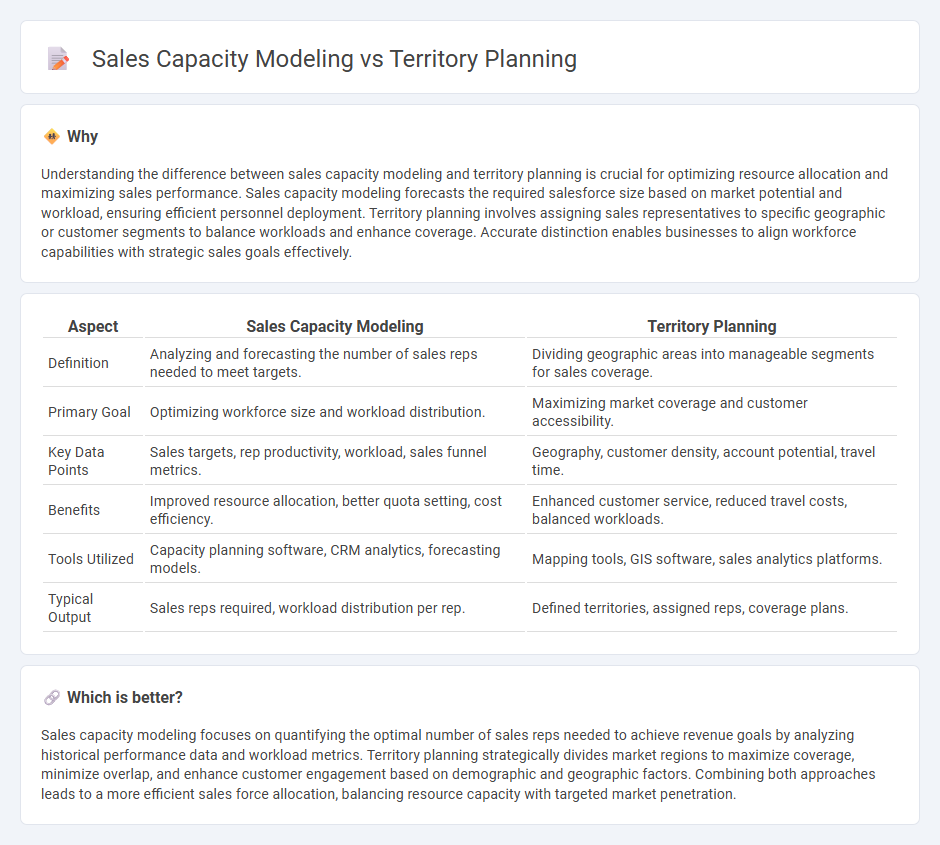
Sales capacity modeling involves analyzing the resources and manpower needed to meet sales targets, ensuring optimal allocation of sales personnel based on workload and potential revenue. Territory planning focuses on defining and distributing geographic or market segments to sales teams to maximize coverage and minimize overlap. Explore how integrating sales capacity modeling with territory planning can boost sales efficiency and performance.
Why it is important
Understanding the difference between sales capacity modeling and territory planning is crucial for optimizing resource allocation and maximizing sales performance. Sales capacity modeling forecasts the required salesforce size based on market potential and workload, ensuring efficient personnel deployment. Territory planning involves assigning sales representatives to specific geographic or customer segments to balance workloads and enhance coverage. Accurate distinction enables businesses to align workforce capabilities with strategic sales goals effectively.
Comparison Table
| Aspect | Sales Capacity Modeling | Territory Planning |
|---|---|---|
| Definition | Analyzing and forecasting the number of sales reps needed to meet targets. | Dividing geographic areas into manageable segments for sales coverage. |
| Primary Goal | Optimizing workforce size and workload distribution. | Maximizing market coverage and customer accessibility. |
| Key Data Points | Sales targets, rep productivity, workload, sales funnel metrics. | Geography, customer density, account potential, travel time. |
| Benefits | Improved resource allocation, better quota setting, cost efficiency. | Enhanced customer service, reduced travel costs, balanced workloads. |
| Tools Utilized | Capacity planning software, CRM analytics, forecasting models. | Mapping tools, GIS software, sales analytics platforms. |
| Typical Output | Sales reps required, workload distribution per rep. | Defined territories, assigned reps, coverage plans. |
Which is better?
Sales capacity modeling focuses on quantifying the optimal number of sales reps needed to achieve revenue goals by analyzing historical performance data and workload metrics. Territory planning strategically divides market regions to maximize coverage, minimize overlap, and enhance customer engagement based on demographic and geographic factors. Combining both approaches leads to a more efficient sales force allocation, balancing resource capacity with targeted market penetration.
Connection
Sales capacity modeling quantifies the resources required to meet revenue targets by analyzing factors such as salesperson productivity, customer demand, and market potential. Territory planning allocates sales resources geographically or by customer segments to maximize coverage and efficiency. Integrating sales capacity modeling with territory planning ensures balanced workload distribution and optimized resource deployment for achieving sales goals.
Key Terms
**Territory Planning:**
Territory planning involves strategically dividing sales regions to maximize coverage and align resources with market potential, ensuring balanced workloads and minimizing overlap. Effective territory planning leverages geographic, demographic, and historical sales data to enhance market penetration and customer engagement. Discover more about how precise territory planning drives sales efficiency and growth.
Segmentation
Territory planning and sales capacity modeling both rely heavily on market segmentation to optimize resource allocation and improve sales performance. Effective segmentation identifies distinct customer groups based on factors like industry, revenue potential, and buying behavior, enabling tailored sales strategies within defined territories. Explore deeper insights into how segmentation drives precision in sales operations and boosts revenue growth.
Geographic Allocation
Territory planning optimizes geographic allocation by dividing sales regions based on market potential, customer density, and competitive landscape to maximize coverage and minimize overlap. Sales capacity modeling quantifies the number of sales representatives needed in each territory to meet demand, balancing workload and resources effectively. Explore detailed strategies to integrate territory planning and sales capacity modeling for enhanced geographic allocation.
Source and External Links
Effective Sales Territory Planning: Steps and Strategies - Outlines a 7-step process for sales territory planning, including analyzing business goals, customer segmentation, SWOT analysis, territory design, action planning, and performance tracking, with best practices for ongoing management.
What's Territory Planning? - Describes how Salesforce's Territory Planning tool helps design, compare, and optimize sales and service territories by importing data, creating models (alignments), and publishing to align with business needs for balanced workload and coverage.
Sales territory planning & management [2025 Best Practices] - Explains different territory models (geographic, account-based, industry, etc.), their advantages and disadvantages, and how choosing the right structure impacts sales efficiency and team dynamics.
 dowidth.com
dowidth.com